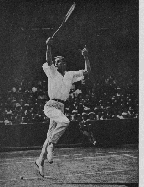|
TennisOne Lessons
Bill Tilden and the Classical Vision, Part One
by Kim Shanley How big was William "Big Bill" Tilden? In the 1920's and 1930's, Bill Tilden was to tennis what Babe Ruth was to baseball. From 1920 to 1926, he won six straight U.S. Championships (the equivalent of today's US Open). He won it for a seventh time in 1929, which still stands as a record (remember Jimmy Connors only won five US Open titles). Although he didn't play in every Wimbledon during his prime years (for a variety of reasons including being banned as professional tennis journalist), he won three Wimbledon crowns. As an amateur from 1912-30, he won 138 of 192 tournaments, and had a match record of 907-62--an unbelievable .936 percent winning percentage. Tennis as an ArtIn today's world, tennis is either a big money professional game played by a few superstars or it's a casual way to have some fun and get a little exercise. "Try to get better," Vic Braden says, "but don't take yourself or your game too seriously, and above all, have fun." Sure, there's a lot to be said for Braden's advice. Who could be against having fun, right? But for those of us who love the game and who would like others to learn to love it, Braden's supreme goal of "fun" leaves me with a queasy sense of mediocre vacuousness . I prefer Tilden's vision. The viewpoint on tennis that stamps a tennis player is that the game is a science and an art. It can reach its highest expression only if a player is willing to study and practice in an attempt to master the game in all its varied facets.Maybe the USTA should pull the plug on its vapid cheerleading "let's-have-fun" campaign, and give tennis its proper respect. While the popularity of tennis has fallen by at least 50 percent in the last twenty years, karate, a sport that promotes itself as a sport that takes years of arduous and painful discipline to master, has grown enormously, particularly with America's youth. To Tilden, a tennis coach is the equivalent of the karate sensei (master). I believe that the only way to get satisfactory results is to be completely frank with a new pupil....If he is a complete beginner, I tell him frankly it will take him a least twenty lessons before he has enough of a game to start to play. I also tell him that it will be about six months before he reaches a point where he gets much real fun out of playing...Anyone who promises quicker results is either an optimist, a miracle worker, or a liar.So what can we in the 1990s learn from a man who won most his last tennis championships in the 1920s? Only the most important thing: we can learn why tennis is more than just about winning or having fun or that highest of modern goals, "getting some exercise." We can learn that tennis is an art which requires "the sum total of physical condition, courage, intelligence, experience, and stroke equipment of a player." |

